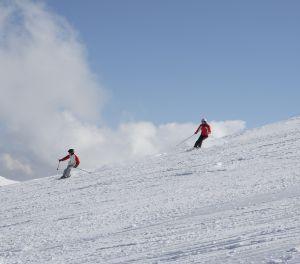We all thank Ullr, the Norse god of snow, when he blesses our mountains with fresh, sparkly powder falling from the skies, but we owe most of our early season turns to the science of snowmaking. Snowmaking is what allows ski areas like Breckenridge Ski Resort to open before we get our first major snowfalls of the winter, but exactly how does it work?

It turns out that snowmaking is a bit more complicated than just turning a hose on and pointing it skyward. In fact, it takes just the right mix of temperature, humidity, water, and compressed air to coat our ski slopes with lovely white snow.
Yo might not be surprised to learn that air temperatures need to be low for blowing snow. In fact, even though 32º F is the freezing point of water, temperatures lower than 28° F are ideal for snowmaking. Equally important is the wet bulb temperature. The wet bulb temperature is a measurement that factors together both the outside air temperature and relative humidity levels. Relative humidity tells us how much moisture, or water vapor, is in the air. For snowmaking, dry conditions are best. Why? Because water cools through evaporation. That’s why your skin feels cooler when your sweat evaporates. When sprayed from the snow guns, droplets of water vapor evaporate a little bit and become colder. When the humidity is high, the air is already saturated with moisture, and the droplets don’t cool as quickly. Dry air makes the water vapor cool much more rapidly, which means it’s easier for those droplets of liquid to become frozen crystals – snow!
 Of course, Breck
can’t make snow without the snow guns! You’ll often see snow guns with
one or two hoses attached to them. These hoses supply the snow guns with
plenty of water and compressed air. The compressed air has a few
purposes: It breaks up the flow of water into tiny water droplets and
blows those water droplets up into the air while also cooling them. Some
snowmaking systems can turn thousands of gallons of water into snow
each minute!
Of course, Breck
can’t make snow without the snow guns! You’ll often see snow guns with
one or two hoses attached to them. These hoses supply the snow guns with
plenty of water and compressed air. The compressed air has a few
purposes: It breaks up the flow of water into tiny water droplets and
blows those water droplets up into the air while also cooling them. Some
snowmaking systems can turn thousands of gallons of water into snow
each minute!We are all excited for the snow making to start. A-Basin is usually the first resort to get moving. I read the following recently in the A-Basin blog.
 "OK, let's do some "Snowmaking 101". Typically, when the wet bulb
temperature is less than 28 F, we start making snow. When the wet bulb
gets less than 25 F and, even better, less than 20 F, we start making
lots of snow. The lower the humidity, the lower the wet bulb
temperature. A cold, clear night with a wet bulb of 20 F is great
snowmaking weather. A warm, stormy day with wet snow falling and a wet
bulb of 33 F is not snowmaking weather."
"OK, let's do some "Snowmaking 101". Typically, when the wet bulb
temperature is less than 28 F, we start making snow. When the wet bulb
gets less than 25 F and, even better, less than 20 F, we start making
lots of snow. The lower the humidity, the lower the wet bulb
temperature. A cold, clear night with a wet bulb of 20 F is great
snowmaking weather. A warm, stormy day with wet snow falling and a wet
bulb of 33 F is not snowmaking weather." We are getting close, but not there yet.
Elevation is ready to support the skiers coming to town with quality ski and snowboard equipment. Breck is posting 13 November as the opening day. Lets keep our fingers crossed that we get some cooler weather.









